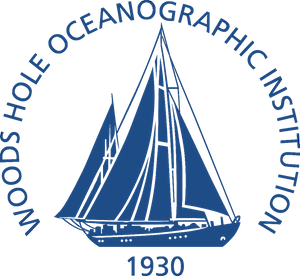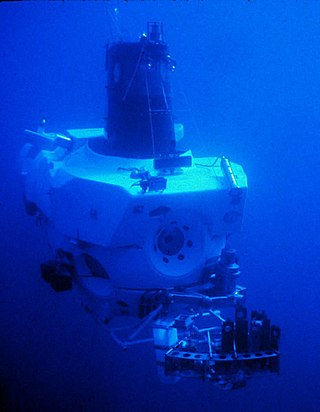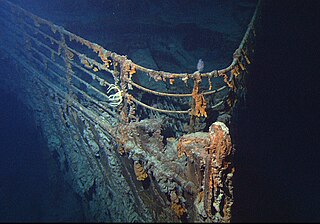
The Woods Hole Oceanographic Institution is a private, nonprofit research and higher education facility dedicated to the study of marine science and engineering.

Alvin (DSV-2) is a crewed deep-ocean research submersible owned by the United States Navy and operated by the Woods Hole Oceanographic Institution (WHOI) in Woods Hole, Massachusetts. The vehicle was built by General Mills' Electronics Group in Minneapolis, Minnesota. Named to honor the prime mover and creative inspiration for the vehicle, Allyn Vine, Alvin was commissioned on June 5, 1964. The submersible is launched from the deep submergence support vessel RV Atlantis (AGOR-25), which is also owned by the U.S. Navy and operated by WHOI. The submersible has made more than 5,000 dives, carrying two scientists and a pilot, to observe the lifeforms that must cope with super-pressures and move about in total darkness, as well as exploring the wreck of Titanic. Research conducted by Alvin has been featured in nearly 2,000 scientific papers.

Robert Duane Ballard is an American retired Navy officer and a professor of oceanography at the University of Rhode Island who is most noted for his work in underwater archaeology: maritime archaeology and archaeology of shipwrecks. He is best known for the discoveries of the wrecks of the RMS Titanic in 1985, the battleship Bismarck in 1989, and the aircraft carrier USS Yorktown in 1998. He discovered the wreck of John F. Kennedy's PT-109 in 2002 and visited Biuku Gasa and Eroni Kumana, who saved its crew.

A deep-submergence vehicle (DSV) is a deep-diving crewed submersible that is self-propelled. Several navies operate vehicles that can be accurately described as DSVs. DSVs are commonly divided into two types: research DSVs, which are used for exploration and surveying, and DSRVs, which are intended to be used for rescuing the crew of a sunken navy submarine, clandestine (espionage) missions, or both. DSRVs are equipped with docking chambers to allow personnel ingress and egress via a manhole.

BRP Gregorio Velasquez is Philippine Navy's first oceanographic research vessel. It was built by the United States Navy as USNS Melville (T-AGOR-14) for university support of Navy programs. The ship was operated as the research vessel R/V Melville by the Scripps Institution of Oceanography for oceanographic research. As the R/V Melville, it was the oldest active vessel in the academic research fleet, collectively known as the University-National Oceanographic Laboratory System (UNOLS) (UNOLS). The US Government confirmed on 17 November 2015 that the Melville was to be transferred to the Philippine Navy as Excess Defense Articles (EDA)s. The vessel was officially transferred to the Philippines on 28 April 2016 and was commissioned into active service at the same time with the Philippine Navy.
DSV-4 is a 25-ton, crewed deep-ocean research submersible owned by the United States Navy, now known only by its hull number, not by its former name.

Argo is an unmanned deep-towed undersea video camera sled developed by Dr. Robert Ballard through Woods Hole Oceanographic Institute's Deep Submergence Laboratory. Argo is most famous for its role in the discovery of the wreck of the RMS Titanic in 1985. Argo would also play the key role in Ballard's discovery of the wreck of the battleship Bismarck in 1989.
The Acoustically Navigated Geological Underwater Survey (ANGUS) was a deep-towed still-camera sled operated by the Woods Hole Oceanographic Institute (WHOI) in the early 1970s. It was the first unmanned research vehicle made by WHOI. ANGUS was encased in a large 12-foot (3.7 m) steel frame designed to explore rugged volcanic terrain and able to withstand high impact collisions. It was fitted with three 35 mm color cameras with 400 feet (120 m) of film. Together, its three cameras were able to photograph a strip of the sea floor with a width up to 200 feet (61 m). Each camera was equipped with strobe lights allowing them to photograph the ocean floor from 35 to 50 feet above. On the bottom of the body was a downward-facing sonar system to monitor the sled's height above the ocean floor. It was capable of working in depths up to 20,000 feet (6,100 m) and could therefore reach roughly 98% of the sea floor. ANGUS could remain in the deep ocean for work sessions of 12 to 14 hours at a time, taking up to 16,000 photographs in one session. ANGUS was often used to scout locations of interest to later be explored and sampled by other vehicles such as Argo or Alvin.

Mary Sears was a Commander in the United States Naval Reserve and an oceanographer at the Woods Hole Oceanographic Institution (WHOI).

RV Atlantis is a Thomas G. Thompson-class oceanographic research ship, owned by the US Navy and operated by the Woods Hole Oceanographic Institution as part of the University-National Oceanographic Laboratory System (UNOLS) fleet. She is the host vessel of DSV Alvin. She is named for the first research vessel operated by WHOI, the sailboat RV Atlantis, for which the Space ShuttleAtlantis is also named.

RV Knorr was a research vessel formerly owned by the U.S. Navy and operated by the Woods Hole Oceanographic Institution for the U.S. research community in coordination with and as a part of the University-National Oceanographic Laboratory System (UNOLS) fleet. On March 14, 2016, Knorr was officially transferred to the Mexican Navy and renamed Rio Tecolutla. She was replaced at Woods Hole by the RV Neil Armstrong. Knorr is best known as the ship that supported researchers as they discovered the wreck of the RMS Titanic in 1985. R/V Knorr (AGOR-15) has traveled more than a million miles—the rough equivalent of two round trips to the Moon or forty trips around the Earth. Her sister ship is the RV Melville.

Jason is a two-body remotely operated vehicle (ROV) designed, built, and operated by the National Deep Submergence Laboratory of the Woods Hole Oceanographic Institution (WHOI). Construction of Jason began in 1982 and was first launched in 1988, redesigned in 2002 as the second iteration of the ROV. The ROV allows scientists and explorers to have access to the seafloor without leaving the deck of a ship.
Jason Junior, also called JJ, was a small remotely operated vehicle (ROV) designed and built by the Deep Submergence Laboratory at the Woods Hole Oceanographic Institute (WHOI). Jason Jr. was a prototype for a larger, more capable ROV named Jason, which was being developed to complement the Argo unmanned undersea video camera sled.

USS Snatch (ARS-27), well known as Scripps RV Argo after conversion to scientific research, was a Diver-class rescue and salvage ship commissioned by the U.S. Navy during World War II and in service from 11 December 1944 through 23 December 1946. Her task was to come to the aid of stricken vessels. The ship is better known from her scientific research role as the Scripps Institution of Oceanography (SIO) research vessel RV Argo. It is that name, apparently not formally recognized by Navy that maintained title to the vessel, found in the scientific literature and public releases about her wide ranging research voyages.

PNA Dr. Bernardo A. Houssay (MOV-1) is a ketch rigged sail training and research vessel for the Argentine Naval Prefecture. Originally named the RV Atlantis, she served as the first and main research vessel for the Woods Hole Oceanographic Institution from 1931 to 1966. Several ships, including RV Atlantis (AGOR-25) and the Space ShuttleAtlantis (OV-104) were named after Atlantis. Having sailed over 1,300,000 miles to date, she is the oldest serving oceanographic research vessel in the world.

Anton Dohrn was a motor yacht built during 1911 and delivered to the Carnegie Institution of Washington in June 1911 for use at its Department of Marine Biology laboratory at Dry Tortugas, Florida. The institution leased the vessel to the United States Navy for use as a patrol boat during World War I to serve as USS Anton Dohrn 5 October 1917 – 2 January 1919. The vessel remained in service for the institution until 1940 when Anton Dohrn was given to the Woods Hole Oceanographic Institution which used the vessel until 1947 for work between the Gulf of Maine and New Jersey. In 1947 the vessel was sold for use as a mail boat between New Bedford and Cuttyhunk Island.

The wreck of the Titanic lies at a depth of about 12,500 feet, about 370 nautical miles south-southeast off the coast of Newfoundland. It lies in two main pieces about 2,000 feet (600 m) apart. The bow is still recognisable with many preserved interiors, despite deterioration and damage sustained hitting the sea floor. In contrast, the stern is completely ruined. A debris field around the wreck contains hundreds of thousands of items spilled from the ship as she sank. The bodies of the passengers and crew would have also been distributed across the sea bed, but have since been consumed by other organisms.

RV Le Suroît is a French research vessel operated by IFREMER. In 1985, it was involved in the successful Franco-American expedition to find the wreck of the RMS Titanic.

Search for the Titanic is a graphic adventure developed by Codesmiths and IntraCorp and published by its subsidiary Capstone Software in 1989. It was released for MS-DOS compatible operating systems, then ported to the Commodore 64. Versions for the Apple II and Amiga were planned, but never reached development. Accolade, Inc. helped to distribute the game. Much of the gameplay is based on Robert Ballard's expedition.















